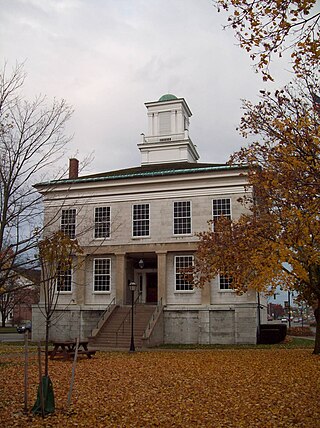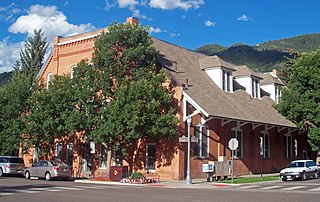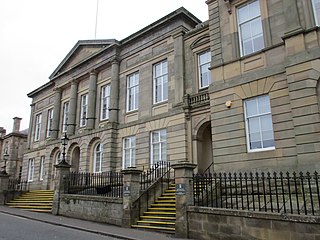
The Old Harrison County Courthouse is located in the center of Whetstone Square in Marshall, Texas and is one of the most famous and admired buildings in Texas. It is the signature landmark of Marshall and is frequently used to represent East Texas in travel literature.

The Belmont County Courthouse is located at 101 West Main Street in St. Clairsville, Ohio, United States. It sits on the highest point in the St. Clairsville area and is thus visible from Interstate 70 and many other points in the Ohio Valley. It is a contributing property in the St. Clairsville Historic District, which was added to the National Register of Historic Places in 1969.

The DeKalb County Courthouse is located in the county seat of DeKalb County, Illinois, U.S., the city of Sycamore. The Classical Revival structure sits on a square facing Illinois Route 64 as it passes through the city. The current courthouse was constructed in 1905 amid controversy over where the courthouse and thus, ultimately, the county seat would be located. The current building is the third structure to bear the name "DeKalb County Courthouse." DeKalb County's Courthouse still serves as the county's primary judicial center and is a contributing property to the Sycamore Historic District. The district joined the National Register of Historic Places in 1978. As the county's primary courthouse for over 100 years, the site has been host to many trials, including prominent murder cases.

The Ogle County Courthouse is a National Register of Historic Places listing in the Ogle County, Illinois, county seat of Oregon. The building stands on a public square in the city's downtown commercial district. The current structure was completed in 1891 and was preceded by two other buildings, one of which was destroyed by a group of outlaws. Following the destruction of the courthouse, the county was without a judicial building for a period during the 1840s. The Ogle County Courthouse was designed by Chicago architect George O. Garnsey in the Romanesque Revival style of architecture. The ridged roof is dominated by its wooden cupola which stands out at a distance.

The Allen County Courthouse is an historic courthouse building located at the corner of North Main Street & East North Street in Lima, Ohio, United States. In 1974, it was added to the National Register of Historic Places.
Yale Lance Galanter is an American lawyer and legal commentator. He is currently a criminal defense attorney based in Miami, Florida. He is best known for representing O. J. Simpson through his 2008 Las Vegas robbery case.

The Hawkins County Courthouse is the seat of county government for Hawkins County, Tennessee, United States, located in the city of Rogersville. It was built in 1836, it is one of six antebellum courthouses still in use in Tennessee, and it is the second oldest courthouse still in use in the state.

The Cuyahoga County Courthouse stretches along Lakeside Avenue at the north end of the Cleveland Mall in downtown Cleveland, Ohio. The building was listed on the National Register along with the mall district in 1975. Other notable buildings of the Group Plan are the Howard M. Metzenbaum U.S. Courthouse designed by Arnold Brunner, the Cleveland Public Library, the Board of Education Building, Cleveland City Hall, and Public Auditorium.

The Genesee County Courthouse is located at the intersection of Main and Ellicott streets in Batavia, New York, United States. It is a three-story Greek Revival limestone structure built in the 1840s.
The Alameda County Superior Court, officially the Superior Court of California, County of Alameda, is the California superior court with jurisdiction over Alameda County as established by Article VI of the Constitution of California. It functions as the trial court for both criminal and civil cases filed in Alameda County.

The Wapello County Courthouse in Ottumwa, Iowa, United States, was built in 1894. It was listed on the National Register of Historic Places in 1981 as a part of the County Courthouses in Iowa Thematic Resource. The courthouse is the fourth building the county has used for court functions and county administration. It is part of the Central Park area, which includes: Ottumwa Public Library, Ottumwa City Hall, and St. Mary of the Visitation Catholic Church.

Aspen City Hall, known in the past as Armory Hall, Fraternal Hall, is located at the intersection of South Galena Street and East Hopkins Avenue in Aspen, Colorado, United States. It is a brick building dating to the 1890s. In 1975 it was listed on the National Register of Historic Places.

The La Fave Block is located at the intersection of East Cooper Avenue and South Hunter Street in Aspen, Colorado, United States. It is a brick commercial building erected in the late 1880s, during the initial mining boom that created Aspen. Today it is the second oldest brick commercial building in the city, and, along with its neighbors on East Cooper, the only structure left built by Frank LaFave, one of Aspen's early settlers. It was listed on the National Register of Historic Places in 1987.

The Red Onion is a restaurant located on East Cooper Avenue in Aspen, Colorado, United States. It is the oldest restaurant in the city, housed in a three-story red brick Italianate building dating to the late 19th century. In 1987 it was listed on the National Register of Historic Places as "New Brick–The Brick Saloon", along with other historic properties in the city.

Pioneer Park, also known as the Henry Webber House or the Webber–Paepcke House, is located on West Bleeker Street in Aspen, Colorado, United States. It is a brick structure erected in the 1880s, one of the few such homes in the city. In 1987 it was listed on the National Register of Historic Places.

The Hotel Jerome is located on East Main Street in Aspen, Colorado, United States. It is a brick structure built in the 1880s that is often described as one of the city's major landmarks, its "crown jewel". In 1986 it was listed on the National Register of Historic Places. It is operated by Auberge Resorts.

The Garfield County Courthouse, at 8th and Main streets in Pomeroy, Washington, was built in 1901. It is of Late Victorian architecture, designed by Charles Burggraf and built by Spokane contractor August Isle. It was identified as "one of several elaborate county courthouses constructed in Washington around the turn of the century" when it was listed on the National Register of Historic Places in 1974.

Lanark Sheriff Court is a judicial building in Hope Street, Lanark, South Lanarkshire, Scotland. The building, which continues to serve as the local courthouse, is a Category B listed building.

The Carlisle Courts of Justice is a Crown Court venue, which deals with criminal cases, and a County Court venue, which deals with civil cases, in Earl Street, Carlisle, England.

Court justice was administered during the seventeenth and eighteenth centuries in the territories that would become the United States subsequent to the American Revolution in buildings that comprised colonial, county, and municipal structures. The most common local and regional territorial unit for the administration of justice within the English colonies was the county. These structures were designed with varying degrees of size and sophistication based on local needs and budgets and were typically inspired by European precedents which comprised different arrangements of adjudicative, clerical, deliberative, and enforcement oriented spaces and rooms, and featured different architectural motifs and symbolic and functional accoutrements.



















